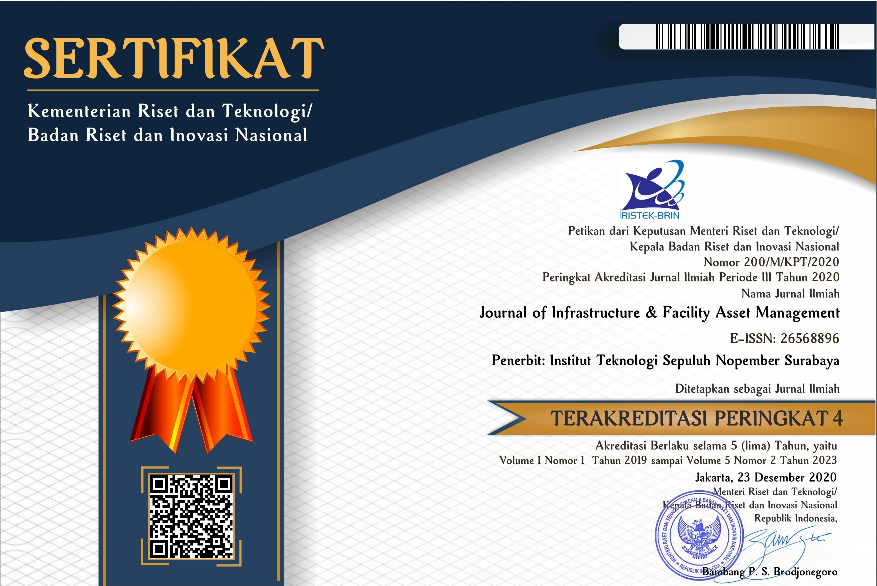The Physical Integration of Smart Transportation Characteristics of Suroboyo Bus and the Feeder
Abstract
Surabaya City is one of the cities in Indonesia that applies smart mobility. In implementing smart transportation, Surabaya city has already had a mode of transportation that supports the implementation of the ITS-ATCS infrastructure, namely Surabaya Bus. Not only to rely on advanced transportation modes and infrastructure facilities, one of the principles of smart transportation is the integration of modes. This study aims to examine the characteristics of physical integration that can be developed and maximized for the application of the Suroboyo bus multimodal smart transportation integration. The research method uses for the analysis is descriptive analysis while the method used for the data collection is primary data collection. The physical integration of smart transportation characteristics of Suroboyo Bus and the feeder such as the use of terminals, the use of bus stops, and transfers, need to maximize their function in the application of the physical integration of smart transportation for Suroboyo bus and feeder transportation.
Full Text:
PDFReferences
Alamsyah, A.S.(2014). Summary Multimoda Transportasi.
Http://Alamsyah76.Blogspot.Com/2014/10/Summary-MultimodaTransportasi.Html
Boyne, S. (2010) Leadership research in hospitality: a critical review, British Academy of Management (BAM) Conference 2010, 14-16 September. University of Sheffield
Carpenter, Andrew (2018). Mobility as a service: first steps.
nationalcenterformobilitymanagement.org
Efendi, Zainal (2018). “Keunggulan Suroboyo Bus, Serba Otomatis Dan Bayar Pakai Sampah”. Detik News. Sabtu, 07 April 2018
Eremia, Mircea, et al. (2017). “The Smart City Concept In The 21 St Century”. Science Direct
ITDP (2019) Panduan Integrasi Antarmoda. Institute For Transportasion & Development Policy-Indonesia.org
Istijanto (2009). Aplikasi Praktis Riset Pemasaran. Gramedia Pustaka Utama. Jakarta.
Kaim, William El. (2016). Mobility as Service. Enterprise Architecture Digital Codex.
Kadarisman, Muh. (2014). “Manajemen Angkutan Lebaran Terpadu”. Jurnal Manajemen Transportasi & Logistik, 2014.
Lennert, Florian et al. (2011). Smart Mobility And Services. European Commission
Litman, Todd (2017). Introduction To Multi-Modal Transportation Planning. Victoria Transport Policy Institute.
Miro, Fidel. (2012). Pengantar Sistem Transportasi. Erlangga. Ciracas.
Nazir, Moh. (2005). Metode Penelitian. Ghalia Indonesia. Jakarta.
Neumann. A, & Nagel. K. (2011). “A paratransit-inspired evolutionary process for public transit network design”. Annual Meeting Preprint-Ähnliche Artikel–Alle 4 Versionen, Berlin.
Nurmandi Achmad (2014). Manajemen perkotaan: teori organisasi, perencanaan, perumahan, pelayanan, dan transportasi mewujudkan kota cerdas. JKSG
Pedersen, Neil. (2016). “Smart Transportation In A Smart City”. Transport Research Board 2016
Salim, H.A Abbas. (2016). Manajemen Transportasi. Rajawali Pers. Jakarta.
Syah, Iman R. (2017.) Membangun Smart City Dengan Pemanfaatan Teknologi Informasi. Academia.edu
Tahir, Anas. (2005). “Angkutan Massal Sebagai Alternatif Mengatasi Persoalan Kemacetan Lalu Lintas Kota Surabaya”. Smartek, Vol. 3, No. 3, Hal. 169-182.
Vespermann & Wald (2011). “Intermodal Integration In Air Transportation: Status Quo, Motives, And Future Developments”. Journal of Transport Geography 9 (6): 1187-1197
Yigitcanlar, Tan et al. (2008). “Bentham Open Open Access Challenges To Urban Transport Sustainability And Smart Transport In A Tourist City: The Gold Coast, Australia 2008”. The Open Transportation Journal, 2008.
Yulianti, Amlia R. (2013). “Konsep Integrasi Moda Transportasi Publik Di Kota Surabaya Berdasarkan Prefrensi Masyarakat”. Digilib ITS. Surabaya.
Zhang, Y., & Hansen, M. (2008). “Real-Time Intermodal Substitution: Strategy For Airline Recovery from Schedule Perturbation and For Mitigation of Airport Congestion”. Journal of Transportation Research Board 252, 90-99.
DOI: http://dx.doi.org/10.12962%2Fjifam.v3i3.14134
Refbacks
- There are currently no refbacks.
Visitor :
Flag Counter

Journal Of Infrastructure & Facility Asset Management by Institut Teknologi Sepuluh Nopember is licensed under a Creative Commons Attribution-ShareAlike 4.0 International License.





